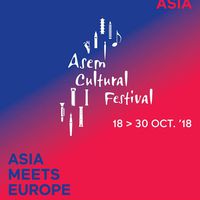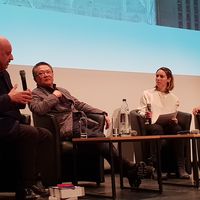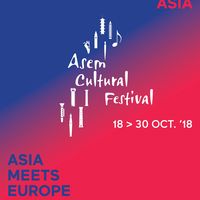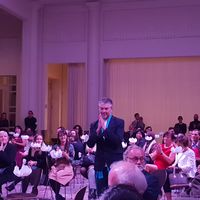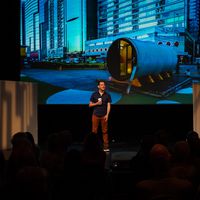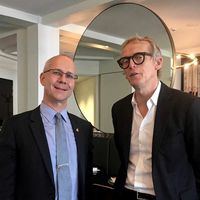Exploring the Influence of Cultural Heritage on Contemporary Architecture

“A Conversation with Wang Shu and Paul Robbrecht” was the title of the architecture forum held on 22 October at the Centre for Fine Arts – BOZAR in the scope of the ASEM Cultural Festival. This Festival is an official side-event of the 12th ASEM Summit (ASEM12) which took place on 18-19 October 2018 in Brussels. ASEM12 brought together Heads of State and Government from the 53 partners of the Asia-Europe Meeting (ASEM) for a dialogue on “Europe and Asia: Global Partners for Global Challenges”.
Dr Steven Everts, Advisor of the European Union External Action Service (EEAS), stated during his introductory speech, the European and Asian partners collaborating within ASEM want to develop cooperation between the two continents by promoting relations and multilateral cooperation.
In line with the ASEM Cultural Festival’s objective to build bridges, foster intercultural dialogue and debate, this conference brought together different visions of cultural spaces, contemporary architecture with a particular focus on heritage, on the occasion of the European Year of Cultural Heritage 2018.
Hosted in one of Brussels’ most prominent cultural venues BOZAR, this event invited two leading architects from Asia and Europe: the 2012 Pritzker Prize Winner, Wang Shu from the Amateur Architecture Studio in China and architect Paul Robbrecht from Robbrecht en Daem architecten in Belgium.
Both world-famous architects have worked intensively on the question of heritage in their architectural productions. Wang Shu with his wife founded the Amateur Architecture Studio, an enterprise which aims to incorporate several elements of Chinese building tradition into modern building construction. Paul Robbrecht is well known for being a master in incorporating his buildings into the surrounding architectural environment. Heritage is not the only common point for these two architects. They both decided despite a very successful and rich professional career to engage in architecture education. Wang Shu is a Professor for Architecture at the Southeast University in Nanjing and the Tongji University in Shanghai, and Paul Robbrecht is a Professor of Architecture at the University of Ghent.
This conference was enriched by the contribution of Hendrik Brinkmann (Germany), Iwo Borkowicz (Poland) and SungBum Heo (South Korea), three shortlisted graduates of the prestigious Young Talent Architecture Award 2018, a prestigious award organised by the Spanish Foundation, Mies van der Rohe with the support of Creative Europe as an extension of the European Union Prize for Contemporary Architecture – Mies van der Rohe Award. This evening led the audience to understand how Europe and Asia connect through architecture. How do architects in Asia and Europe make use of heritage? What do the different ways in which younger and senior architects deal with heritage tell us? Moreover, what can we learn from the confrontation of these generational, geographical and cultural parameters?

Pritzker Prize-winning architect Wang Shu (China) at the architecture forum at the ASEM Cultural Festival
Two distinct ways of approaching heritage in architecture between Europe and China
If there is nothing particular in the way the architects appropriate heritage, an interesting distinction could be observed in the approach of Wang Shu and Paul Robbrecht which is due to the economic and political developments of the last century. Paul Robbrecht explained that one of the major challenges he faced in building the Concertgebouw in Bruges, was the already very rich architectural landscape. He explained how he had to design his building, not in a submissive but in a respectful manner. As China went through a different type of development phase, combining cultural revolution with an extremely rapid economic development, cities appearances have changed, older buildings have been destroyed to be replaced by quickly constructed concrete buildings. The incorporation of traditional handicrafts and construction with local materials enables Wang Shu to reconnect Chinese architecture to a blanked out past. Focusing on heritage permitted to underline the different challenges contemporary architects are facing in China and Europe.
Heritage as a source of inspiration
The conversation and the presentation of the work of the three young graduates made clear how heritage represents a major source of inspiration for contemporary architectural creations. Throughout the evening the participants discussed what heritage means for them precisely. They all agreed on the fact that heritage does not consist of constructing new buildings to make them look like old buildings, or in Wang Shu’s words to make “false old buildings”. The young architect Hendrick Brinkmann said that during his project, which consisted in rebuilding the Bau-Akademie in Berlin’s city center, he wanted to “avoid simply building the simulacre of an ancestor”, even if he stated that it was important to find obvious references to the iconic building of G.F. Schinckel through the occurrence of pillars very similar to the original building. Paul Robbrecht underlined several times how the observation of gothic cathedrals in the north of France allowed him to find inspiration and made clear how pretending to build a monument from scratch is somehow pretentious.

Belgian architect Paul Robbrecht addressing the audience at the architecture forum at the ASEM Cultural Festival
Broadening the meaning of heritage
Contemporary architects have even broadened the meaning of heritage which is a strong source of inspiration for them. This was particularly striking as illustrated by the projects of the young architect Iwo Borkowicz. His project aims to solve the housing crises in Havana Vieja, a neighbourhood in the centre of Havana. He aims to foster handicraft and preserve the typical houses thereby combining social and touristic housing. This desire to strive for the protection of traditional know-how is also central in several works of Wang Shu, in particular in his project regarding the Ningbo historical museum which is making use of local recycled materials and relies on traditional techniques for the construction of the windows.
Is heritage in architecture looking back to the past or forward to the future?
Finally, a noteworthy point of this discussion was how the focus on heritage was not only centred on the preservation of a certain past but was very much anchored in our contemporary world. For Wang Shu, thinking about heritage is something very modern because it builds upon memories which are triggered by the contemporary environment we live in. Both senior and young architects are striving, as highlighted by Hendrik Brinckmann, to construct their buildings according to the actual needs of their future users. By making use of traditional handicraft, Iwo Borkowicz and Wang Shu allow these techniques not only to survive but also allow them to further develop. Paul Robbrecht’s invitation to involve a contemporary artist to exhibit work at the market hall and central square of Ghent means that the Ghent city centre is not only revitalised, but it also creates an interesting dialogue between contemporary artistic practice and heritage. Moreover, by seriously considering sustainability issues in their buildings, the architects are focusing on finding solutions to fight against negative aspects of the development of modern cities such as savage gentrification, by combining tourist accommodation and social housing, or unsustainable architecture by using a lot of recycled and local construction materials.
To conclude, by thinking about the role of heritage in contemporary architecture we wonder whether heritage is about the past or the future?
~~~
The ASEM Cultural Festival took place from 18-30 October 2018 at the Centre for Fine Arts-Brussels (BOZAR) in Brussels, Belgium alongside the 12th ASEM Summit (ASEM12) (18-19 October 2018, Brussels), which brought together Heads of State and Government from the 53 partners of the Asia-Europe Meeting (ASEM) for dialogue on “Europe and Asia: Global Partners for Global Challenges”.
The ASEM Cultural Festival was a celebration of dance, digital art, film, music, theatre and visual arts from Asia and Europe and featured among others Ariunbaatar Ganbaatar (Mongolia), Bi Gan (China), Honore d’O (Belgium), Pichet Klunchun (Thailand), Wang Shu (China), and Svetlana Berezhnaya (Russia).
ASEM Cultural Festival Programme: https://bit.ly/asemfest
The festival was organised – as an official side event of ASEM12 – by Centre for Fine Arts-Brussels (BOZAR) with the support of the Asia-Europe Foundation (ASEF) and the European Union, the host of ASEM12.
www.ASEF.org
Similar content
from - to
18 Oct 2018 - 30 Oct 2018
from - to
22 Oct 2018 - 22 Oct 2018
from - to
18 Oct 2018 - 30 Oct 2018
By culture360
19 Oct 2018
11 Oct 2018
By culture360
19 Oct 2018

